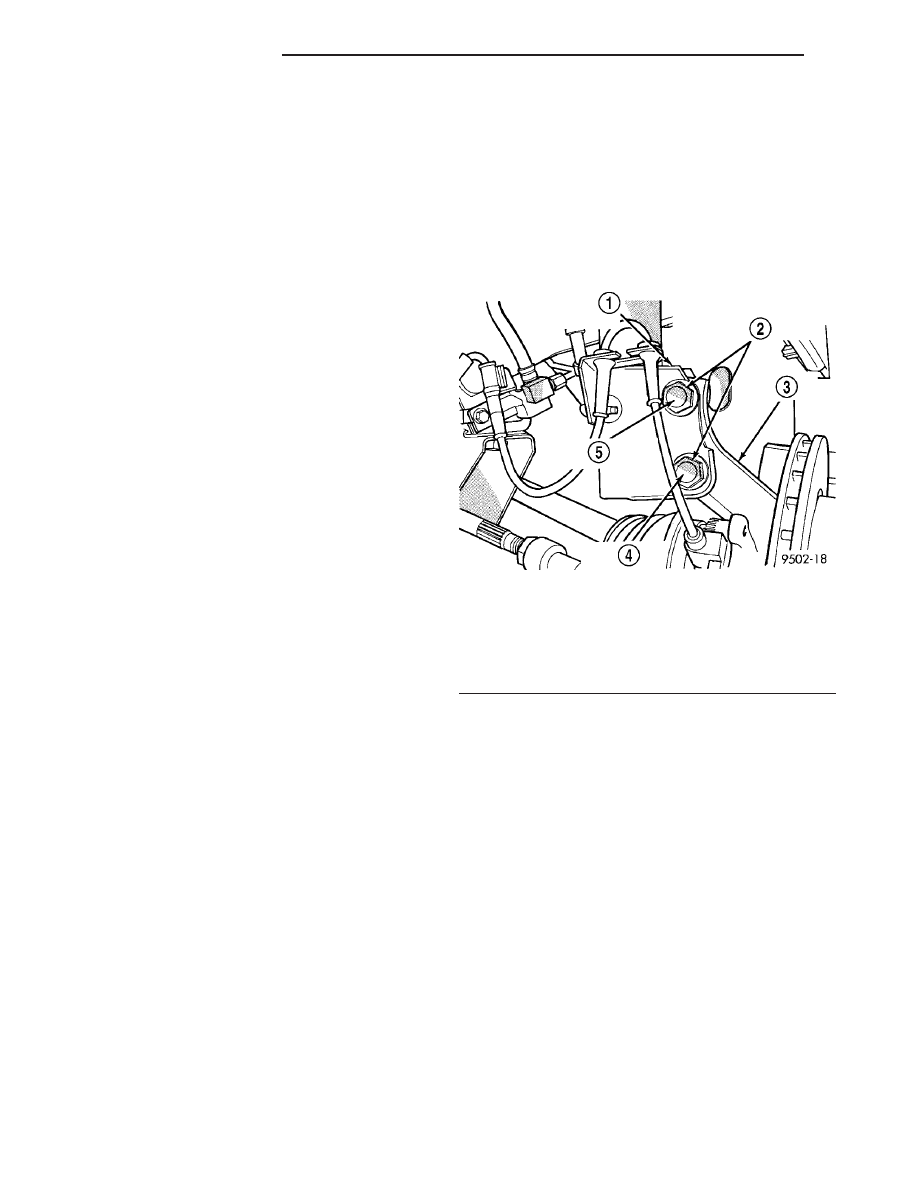Chrysler PT Cruiser. Manual - part 406

(6) Tighten the four mounting bolts to a torque of
95 N·m (70 ft. lbs.).
(7) Reassemble the rear brake following the Spin-
dle Installation procedure found in Rear Suspension.
(Refer
to
2
-
SUSPENSION/REAR/SPINDLE
-
INSTALLATION)
(8) Reinstall the tire and wheel assembly. Tighten
the wheel mounting nuts to a torque of 135 N·m (100
ft. lbs.).
(9) Lower the vehicle.
(10) Once rear camber and toe have been set to
specifications, check and adjust the front wheel align-
ment as necessary. Refer to FRONT CAMBER AND
CASTER and FRONT TOE within this wheel align-
ment service procedure.
FRONT CAMBER AND CASTER
Front camber and caster settings on this vehicle
are determined at the time the vehicle is designed,
by the location of the vehicle’s suspension compo-
nents. This is referred to as Net Build. The result is
no required adjustment of camber and caster after
the vehicle is built or when servicing the suspension
components. Thus, when performing a wheel align-
ment, caster and camber are not normally considered
adjustable angles. Camber and caster should be
checked to ensure they meet vehicle specifications.
(Refer to 2 - SUSPENSION/WHEEL ALIGNMENT -
SPECIFICATIONS)
If front camber is found not to meet alignment
specifications, it can be adjusted using an available
camber adjustment bolt package. Before installing a
camber adjustment bolt package on a vehicle found
to be outside the specifications, inspect the suspen-
sion components for any signs of damage or bending.
No adjustment can be made to the caster setting
on this vehicle. If the vehicle’s caster is not within
alignment specifications, check for damaged suspen-
sion components or body parts.
CAUTION: Do not attempt to adjust the vehicles
wheel alignment by heating or bending any of the
suspension components.
CAMBER ADJUSTMENT BOLT PACKAGE INSTALLATION
The camber adjustment bolt package contains new
bolts and nuts for attaching the strut clevis bracket
to the steering knuckle. The bolts contained in the
package are slightly undersize allowing for move-
ment between the strut clevis bracket and the steer-
ing knuckle. The movement allowed by the undersize
bolts provide approximately two degrees of camber
adjustment per side of the vehicle. To install and
adjust the camber adjustment bolt package, follow
the procedure below.
(1) Raise the vehicle until its tires are not support-
ing the weight of the vehicle.
CAUTION: The knuckle to strut assembly attaching
bolt shanks are serrated and must not be turned
during removal. Remove the nuts while holding the
bolts stationary.
(2) Remove the original upper bolt attaching the
strut clevis bracket to the knuckle (Fig. 7).
(3) Install a bolt from the adjustment package into
the hole where the original bolt was removed. Install
the bolt from the rear.
(4) Install a nut provided in adjustment package
on the replacement bolt. Tighten the nut until it’s
snug, but still allowing the knuckle to slide in the
clevis bracket.
(5) Remove the original lower bolt.
(6) Install a bolt from the adjustment package into
the bottom hole of the strut clevis bracket. Install the
bolt from the rear.
(7) Install a nut provided in adjustment package on
the replacement bolt. Tighten the nut until it’s snug.
(8) Reinstall the tire and wheel assembly. Tighten
the wheel mounting nuts to a torque of 135 N·m (100
ft. lbs.)
(9) Perform the above procedure to opposite strut
as required.
(10) Lower the vehicle and jounce the front and
rear of the vehicle.
(11) Adjust the front camber to the preferred set-
ting by pushing or pulling on the top of the tire.
When camber is set to specifications, tighten the
Fig. 7 Front Strut Clevis Bracket Attaching Bolts
1 - STRUT CLEVIS BRACKET
2 - STRUT CLEVIS BRACKET TO STEERING KNUCKLE
ATTACHING BOLTS
3 - STEERING KNUCKLE
4 - LOOSEN THIS BOLT
5 - REMOVE AND REPLACE THIS BOLT
2 - 60
WHEEL ALIGNMENT
PT
WHEEL ALIGNMENT (Continued)